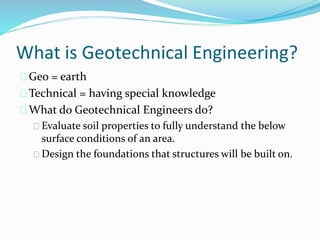The 6-Second Trick For Geotheta
The 6-Second Trick For Geotheta
Blog Article
Unknown Facts About Geotheta
Table of ContentsThe Ultimate Guide To GeothetaGeotheta Fundamentals ExplainedWhat Does Geotheta Mean?About GeothetaUnknown Facts About Geotheta

They carry out website investigations, gather samples, perform lab examinations, and analyze data to review the viability of the ground for construction jobs - Engineer of Record. Based on their findings, geotechnical engineers supply referrals for foundation design, slope stability, preserving frameworks, and mitigation of geotechnical risks. They work together with various other specialists, such as engineers, architectural engineers, and construction groups, to make certain that geotechnical considerations are integrated right into the total task layout and execution
By assessing the behavior and residential properties of dirt and rock, they can recognize possible geotechnical threats such as landslides, soil settlement, or incline instability. Their knowledge helps prevent failures or crashes that can jeopardize lives and residential or commercial property. Here are some comprehensive responsibilities and responsibilities of a geotechnical designer: Website Investigation: Geotechnical engineers conduct site investigations to collect data on subsurface conditions.
They translate the information to understand the properties and habits of the dirt and rock, including their toughness, permeability, compaction qualities, and groundwater conditions. Geotechnical Analysis and Design: Geotechnical engineers evaluate the data gathered during site investigations to assess the stability and suitability of the site for construction projects. They carry out geotechnical calculations and modeling to assess factors such as bearing capacity, negotiation, incline security, lateral earth pressures, and groundwater flow.
Geotheta Things To Know Before You Get This
Structure Layout: Geotechnical designers play a critical role in creating structures that can securely support the designated structure. They evaluate the soil problems and load requirements to identify the appropriate foundation kind, such as shallow structures (e.g., footings), deep structures (e.g (https://www.producthunt.com/@geotheta1)., piles), or specialized methods like soil renovation. They take into consideration elements such as settlement limits, bearing capacity, and soil-structure interaction to develop optimum foundation styles
They examine construction strategies, display website tasks, and conduct field assessments to confirm that the design recommendations are followed. If unforeseen geotechnical problems arise, they evaluate the scenario and supply referrals for remediation or adjustments to the design. Threat Analysis and Mitigation: Geotechnical engineers evaluate geotechnical threats and risks connected with the job site, such as landslides, liquefaction, or soil erosion.

Cooperation and Communication: Geotechnical designers function closely with other professionals associated with a task, such as architects, architectural engineers, and construction groups. Efficient communication and partnership are necessary to integrate geotechnical factors to consider into the overall task style and construction procedure. Geotechnical designers offer technological expertise, response queries, and make certain that geotechnical requirements are satisfied.
What Does Geotheta Mean?
Below are some sorts of geotechnical designers: Structure Designer: Structure designers concentrate on creating and analyzing structures for structures. They analyze the dirt conditions, load needs, and website features to figure out one of the most ideal structure type and design, such as superficial structures, deep structures, or specialized techniques like pile structures.
They assess the variables affecting slope security, such as soil homes, groundwater conditions, and incline geometry, and develop methods to avoid incline failings and reduce dangers. Quake Engineer: Earthquake designers focus on analyzing and designing frameworks to stand up to seismic forces. They assess the seismic risk of a website, assess dirt liquefaction capacity, and establish seismic layout criteria to guarantee the safety and security and strength of structures throughout quakes.
They perform area screening, collect examples, and examine the collected information to identify the soil residential properties, geologic formations, and groundwater conditions at a website. Geotechnical Instrumentation Engineer: Geotechnical instrumentation engineers focus on tracking and determining the behavior of soil, rock, and frameworks. They mount and maintain instrumentation systems that check variables such as dirt settlement, groundwater degrees, incline motions, and structural variations to assess efficiency and offer very early warnings of potential concerns.
Not known Details About Geotheta
They perform tests such as triaxial tests, consolidation examinations, straight shear examinations, and permeability examinations to gather information for geotechnical analysis and style. Geosynthetics Engineer: Geosynthetics designers focus on the style and application of geosynthetic products, such as geotextiles, geogrids, and geomembranes. They use these materials to enhance dirt stability, reinforce inclines, provide drain options, and control erosion.
They often tend to be investigative individuals, which indicates they're intellectual, reflective, and curious. They are interested, systematic, logical, logical, and sensible. Several of them are also social, implying they're kind, generous, participating, person, caring, practical, understanding, skillful, and pleasant. Does this noise like you? Take our totally free job test to learn if geotechnical engineer is just one of your leading occupation matches.
In the workplace environment, geotechnical engineers utilize specialized software devices to carry out computations, produce styles, and evaluate information. They prepare reports, testimonial job specifications, communicate with clients and group participants, and coordinate project tasks. The workplace setting gives a conducive atmosphere for study, analysis, and collaboration with various other experts included in the project.
Geotheta for Dummies
They frequently go to project websites to conduct website investigations, evaluate geotechnical problems, and gather data for evaluation. These sees include taking a trip to different places, sometimes in remote or tough terrains. Geotechnical designers might execute dirt sampling, conduct tests, and screen building and construction tasks to ensure that the geotechnical facets of the job are being applied properly.
Geotechnical designers additionally operate in specialized geotechnical laboratories. In these facilities, they carry out experiments, execute examinations on soil and rock examples, and assess the engineering properties of the materials. Geotechnical lab click here for info designers work extensively in these settings, handling screening devices, running tools, and tape-recording information. They collaborate with other research laboratory staff to make certain exact and reputable screening results.
Report this page